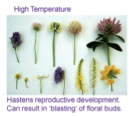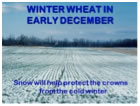Competency Area 1: Crop Adaptation
PO 4. Understand the adaptation of major Northeast crops to extremes in temperature.
A. Understand the response of corn to a late-spring or early-fall frost,
B. What factors are responsible for successful over-wintering of alfalfa, perennial grasses and winter wheat.
Growth and development at extreme temperatures:
High temperatures accelerate growth and development. Growth ceases at high temperature extreme. High temperatures during grain-filling promote senescence and premature cessation of grain-growth. Corn, wheat, and soybeans will attain physiological maturity 1-2 weeks earlier than normal under high temperatures and dry conditions during grain-filling.
Cool temperatures retard growth and development. Cool nights, especially, slow the growth of summer crops and result in a late harvest. Grain yields, however, can be higher under these conditions because of the extended grain-filling period.
Corn and soybeans can be found in short-season hybrids and varieties which have expanded the adaptation north and it is now possible to grow corn for grain and soybeans in Northern NY and Northern New England where the growing season is only 120 days long. Optimum temperatures for corn and soybeans- 80-85°, maximum temperatures 95-100°, minimum temperatures 40-45°. Corn and soybeans yield best when average high temperatures are 80 degrees in July and August with average low temperatures of about 60. Higher temperatures, especially under dry conditions, can reduce the yield of both crops.
A) Understand the response of corn to a late-spring or early-fall frost.
Corn can tolerate temperatures from 29-32 degrees before the 5th leaf-stage (May to mid-June) because the growing point is below the ground (i.e. corn can tolerate early season frost). Soybeans can also tolerate a light frost (30 degrees) at the cotyledon or unifoliate stage (May and early June) because side growth terminals will take the place of the lead terminal. Soybeans will not tolerate frost after this period. Corn and soybeans, however, will die with an extended period (>4 hours) of temperatures less than 28 degrees at all stages of growth.
B) What factors are responsible for successful over-wintering of alfalfa, perennial grasses and winter wheat.
Fall harvest management of alfalfa: Historically, alfalfa harvest was discouraged between Sept. 1 and Oct. 15, to allow alfalfa to build up root reserves prior to overwintering. With advances in alfalfa breeding, however, this recommendation has been updated, with less emphasis on calendar date. As long as there is a 6-7 week rest interval between the second-to-last and last harvests of the season, the date of the final harvest has less significance. There may be some advantage to having alfalfa regrow at least 6-8 inches before a killing frost, to allow this regrowth to catch and hold a snow cover. Most often it is a combination of events that determines whether an alfalfa stand will survive. A full stand of alfalfa can be considered to have 4 live plants per square foot, or about 40+ shoots per square foot.
Winter wheat, and in most years, winter barley are well-adapted to central and western NY and New England because snow cover protects the crown from damage. Also, winter wheat has inherently high tolerance to cold winter temperatures, whereas winter barley has less tolerance. Thus, winter wheat is better adapted to the Northeast than winter barley. Winter wheat and barley are not adapted to Northern NY or Northern New England. Oats will winter kill throughout the entire Northeast region (except maybe Long Island area).
Quick Links
- Competency Area 1: Crop Adaptation
- Competency Area 2: Crop Staging, Growth, and Development
- Competency Area 3: Tillage Systems
- Competency Area 4: Seeding Factors
- Competency Area 5: Seeding Rates and Row Spacing
- Competency Area 6: Considerations in Replanting Decisions
- Competency Area 7: Forage Harvesting Factors
- Competency Area 8: Cropping Systems


